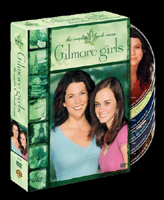 BUY IT AT AMAZON: CLICK HERE!
BUY IT AT AMAZON: CLICK HERE!
STUDIO: Warner Bros.
MSRP: $59.98
RATED: Unrated
RUNNING TIME: 959 Minutes
SPECIAL FEATURES:
• Deleted scenes
• Factoid commentary on one episode
• Romantic clip sequence
• Stars Hollow Challenge trivia quiz
For a
standard, seven-season show, the fourth season is the dividing line, the dead
center. It is equivalent to the third act of a stage play, the complication. In
Buffy,
for example, the fourth season crippled Spike and made it possible for him to
play the popular role for the remaining three. In Gilmore Girls, the event
of note is Rory’s departure for Yale, and the ensuing, occasionally saccharine,
life lessons. This show has always been fascinated with the concept of
maturity, but this season the writers make it their primary focus, and deliver
a conflicted and touching set of episodes.
The Show
The last
three seasons of this much-lauded show featured young Rory Gilmore (Alexis
Bledel) preparing for Harvard, not getting accepted to Harvard, and settling
for Yale. Often the more mature of the mother/daughter duo that gives the show
its name, Rory takes this season to overcompensate, and makes the first really
meaningful mistakes of her life, while Lorelai (Lauren Graham) gets the chance
to stop playing child with her daughter and begins work on her dream project:
the restoration of the Dragonfly Inn.

"Your puppy died. And I just gave you a brain tumor."
Running
behind these main plot arcs are a few individual subplots featuring the
supporting characters, chief among them the marriage difficulties between Lorelai’s
parents, Richard and Emily (played by Edward Herrmann and Kelly Bishop,
respectively). The show is always about Rory and Lorelai, but the writers do a
fine job of populating their home town of
halls of Yale, with a variety of interesting characters that, if not round,
then are at least foreshortened convincingly.
In
reviews past, much has been made of the writing of this show, and all the
critical observations, positive and negative, are deserved. The writing is
clever, laden with pop-culture references, and quicker than Tarantino making a
pitch to the Muppets. The heavily referential dialogue makes for some instant
fans for those already in the know, but at the same time distances a lot of
viewers who have to absorb the reference through context alone.
For as
much as the writing draws on outside influences, there is an equal amount of
internal coherency. Individual characters have very distinct voices, and their
patterns of speech and comfort phrases make them immediately distinguishable.
The only exceptions are Lorelai and Rory, whose lines are often very similar,
but I wouldn’t consider that a negative criticism: there’s too many great bits
of dialogue in that mode to fit them all into one character, anyway.
The
actors, one and all, prove themselves deft hands at interpreting the writing. Obvious
standouts are Lauren Graham and Kelly Bishop, whose verbal sparring matches
reach new highs and lows throughout this fourth season. It’s a pleasure to
watch as simple words are manipulated like scalpels by both actors, sometimes
slicing their opponent, sometimes turning back under their own skins.
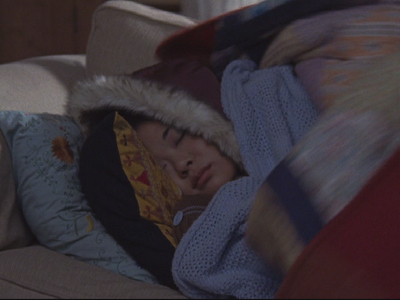
You know how you can’t tell who someone is if they’re not wearing their glasses?
I feel like that all the time.
Alexis
Bledel doesn’t get much of the interesting drama for the first half of the
season; instead, she is saddled with a few interesting setups that don’t pay
off for a couple of discs (or, measured in original air time, months). As Rory
heads out on her path of mild, East Coast self-annihilation, more is asked of
Ms. Bledel, and she manages the shift from goody two-shoes to
slightly-muddy-shoes in a gentle gradient.
Despite
the fine acting on all fronts, there is the serious complaint that these
characters may just not be likeable to the viewers. Usually, it’s pretty clear
when a character is meant to be sympathetic, but with Gilmore Girls, it’s a bit
hard to tell. The thing is, it’s a show set in rich
Even the people who aren’t wealthy seem to do well-enough on their own, raising
a teenage daughter, without having had a college education. The whole setup
reeks of entitlement, and this confuses the drama, as scenarios that are
clearly meant to inspire pity in the audience occasionally backfire and bring
on a sort of "dame got what she deserves" reaction.
That sort
of audience member likely doesn’t comprise even a small minority of regular Gilmore
Girls viewers, and there are certainly enough of the other type to keep
the show going strong. It’s not a show that appeals to many males, because of
the heavily gynocentric base scenario. Even the male characters, such as Luke,
are feminist riffs on masculine archetypes, the ruggedly handsome man with a
heart of gold. Dave Sim would be outraged. Hell, Dave Sim is probably outraged
anyway.
It would
be a mistake, though, to allow such a buried structure to interfere with the
enjoyment of a show that is, basically, escapist in nature. The characters may
inspire more envy than sympathy, but their dramatic interactions ought to be
fascinating to just about anyone with an interest in interpersonal politics.
Assuming that Gilmore Girls creator Amy Sherman-Palladino’s motive was to
create and resolve reasonable tensions between well-written, and well-acted,
characters, then the show is a complete success.
8 out of 10
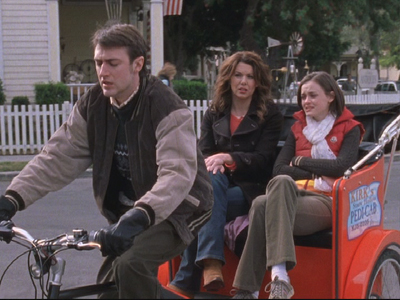
No one’s happy. If no one’s happy, I’m happy.
The Look
1.33:1
fullscreen. There’s a classic quality to the photography throughout the show, a
sort of warm glow that reminds the viewer of elegance. I can’t tell if it was
intentional, but it gives a comforting tone to the whole season. This is a show
that doesn’t focus on spectacle, but rather on character conversation, so there
are a lot of two-shots. In the few times that interesting or unusual camera
angles are experimented with, they are distracting. The transfer is solid and
clean.
7 out of 10
The Noise
Dolby Digital 2.0. I’m very happy the quality of the sound in this set. The mix is
vital in a show so laden with dialogue, and all of it comes across cleanly. There’s
a potential for the rapid witticisms to get muddy; they are, occasionally, in
coherency, but not in sound quality.
The signature
music is repetitive, a hypnotic blend of "la la" harmony that never
fails to bring the tone of whichever episode down a notch or two.
6.5 out of 10
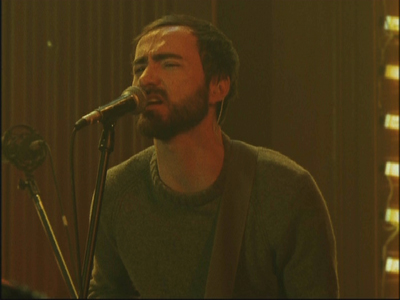
Ladies and gentlemen, the voice of helium: James Mercer of The Shins.
The Goodies
The
special features are pretty slim for this set. There are four bonuses of note
(discounting the subtitles, because, well, we all love subtitles already, and
they’re starting to feel embarrassed) split evenly between useless and decent.
On the
decent, but skimpy, side are a couple of deleted scenes. These are about what you’d
expect: nothing too drastic for TV, just cut for length. The first scene comes
from the season premier, "Ballrooms & Biscotti". It’s a meeting
between Lane and Rory in which we find out that Lane has been sentenced to
attend to Seventh-Day Adventist college. The other deleted scene is from
episode 16, "The Reigning Lorelai". It’s a short scene, involving a
small confrontation between Lorelai and her current manfriend, Jason.
The other
welcome bonus is a set of pop-up factoids for episode 17, "Girls in
Bikinis, Boys Doin’ the Twist". Throughout the running time, text
commentary appears on your screen, offering tidbits about the filming of the
episode, the characters, the actors, etc. Did you know that Alexis Bledel’s
first language was Spanish? This feature is contained on disc six, completely
separate from the disc its associated episode appears on.
The other
bonuses are throwaways: a clip segment called "Who Wants To Get
Together?" featuring the romantic bits of the season, and "Stars
Hollow Challenge", a trivia game that offers zero replayability, and only
minor gloating privileges.
There’s
also a handy little booklet included with the set that contains a glossary of
unfamiliar terms, so you can be in on some of the jokes. You know, in case
you’re stupid or something.
4 out of 10
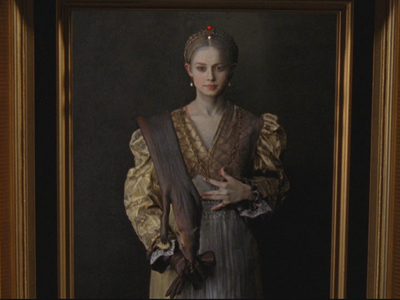
Woo! Take it off! Woo!
The Artwork
This
supports my argument that the show is about a subset of
call "French". The design and layout are reminiscent of a good Martha
Stewart arrangement, but, really, it’s appropriate. And there’s no denying that
both Lauren Graham and Alexis Bledel are nice people to look at.
6 out of 10
Overall 7.5 out of 10